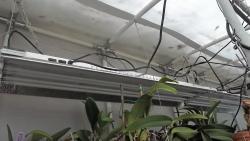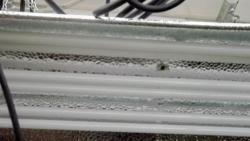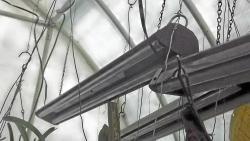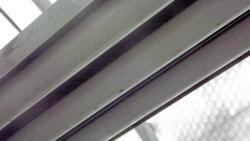To put it simply, the light wave will go from one extreme, infrared, to the other extreme, ultraviolet, and the light wave length is measured in nanometers, or Kelvin. There are higher and lower wave lengths, such as x-rays, but let's limit it to the infrared and ultraviolet. The human eye cannot see either of these extremes and plants get no value from them. Infrared is what causes sunburn (in animals as well as plants) and ultraviolet causes cellular changes/genetic changes in animals and plants. The UV is what causes skin cancer, for example.
For practical purposes, incandescent lights produce a very low K, use a lot of wattage, get very hot, and don't last long. Their K is in the range of about 2700 and that would be the "yellow" range. Plants don't really use that range of light for photosynthesis or flowering, and incandescent lighting therefore won't help you much if you use it for supplemental light.
For simplification, let's just discuss the more commonly found fluorescent tubes/bulbs: the T12, the T8, and the T5 sizes. This is simply an approximation, but a T12 tube will be about 1" in diameter, a T8 will be 3/4", and a T5 will be 1/2" in diameter.
A standard fluorescent bulb/tube might have a label of "Warm" and this would still be sort of yellow/pinkish and would be 3000-3500K. You can get "warm" tubes in all the sizes of fluorescent fixtures (T12, T8, and T5) and they are probably the most commonly used bulb for home/office lighting. You might get a little value in the upper range of K tubes if you are trying to get plants to flower.
A "Cool-white" fixture would use tubes that are around 4100K. Again, you can find this in all ranges of tubes, T12, T8, T5, and T5H or T5HO (the same). These tubes are also used routinely in lots of homes/offices, and when it comes to plants, this tube is good for flowering plants -- in other words, to stimulate flowering.
A "Daylight" would have a K of 5000-6500. Now we are getting to tubes that more closely mimic the light we find outside. This range is what you would find in "Gro-lights," but you can also find this in all the sizes of fluorescent tubes. These are the tubes I use in my greenhouses and this is the Kelvin that you most often want to use over your plants. This range aids the plants in their photosynthesis process and thus would help stimulate plant growth.
For most people who want to use something for supplemental light, fluorescent lighting will be the usual choice. The major difference in the T12, T8, and T5 or T5H is not so much in the Kelvin range but in the output (light intensity). The T12 is at the bottom of the list, the T8 produces stronger light, the T5 even stronger light, and the T5H/T5HO the strongest of them all. I use a mix of T8 and T5H, and my light meter (positioned within 2" of the tubes) registers 10,200 lumens under the T8 fixtures. When I measure the same distance from my T5H tubes, the light meter registers 30,000 lumens. Wow! I use 4-tube, T8 fixtures and 6-tube, T5H fixtures, though. A 6-tube, T8 fixture would probably give me only 12,000 lumens.
Other than light intensity, there is one other factor you need to be aware of when choosing fluorescent fixtures and tubes/bulbs. T12 and T8 tubes are cool or slightly warm to the touch. T5 tubes are a little bit warm, but you can touch them without burning your fingers. T5H/T5HO are hot tubes, and if you touch them you'll have burned-fingers. The important thing here is the space between your plants' leaves and the fluorescent tubes. You can easily position the T12, the T8, and the T5 bulbs within 3-4" of the leaves. You might want to feel the T5 tubes though. The heat generated can vary from manufacturer to manufacturer. The T5H/T5HO are a totally different matter. If you have really heat-sensitive leaves, keep those tubes 18" away. If the leaves are tougher and not so heat-sensitive, you might be OK at 12". I keep my orchids approximately 12-15" away from these tubes. Generally speaking, the thinner the leaf the more heat-sensitive it will be. Most tropical plants will grow best in dappled shade, so their leaves will be more heat-sensitive, regardless of leaf thickness.
In my opinion, you should at least try to find T8 tubed fixtures with a K in the 5000-6500 range. If you not only want plant growth, but also want to induce flowering, you might chose a six-bulb fixture, using four 6500 tubes and two 5000 tubes. In that way you are expanding your light wave range. T8 fixtures should be readily available at all the big box stores. They may or may not carry the T5 fixture and probably won't carry the T5H fixture, but perhaps they do. I had to order my T5H fixtures from Amazon and I am using 4', 6-tube 6500K fixtures.

 T5H
T5H

 T8
T8
| Thread Title | Last Reply | Replies |
|---|---|---|
| Part 1! Part 1! Part 1! by droughttolerant | Mar 1, 2015 4:24 PM | 8 |
| A Few Problems in the Details by brandon7 | Mar 1, 2015 7:17 AM | 3 |
| Untitled by donnabking | Mar 1, 2015 7:15 AM | 1 |
| Thank you! by karmatree | Feb 25, 2015 5:37 AM | 0 |
| Good article! by CarolineScott | Feb 24, 2015 3:12 PM | 13 |
| Another Mystery resolved by Oberon46 | Feb 23, 2015 4:44 PM | 1 |